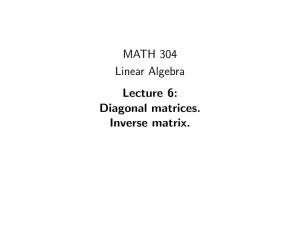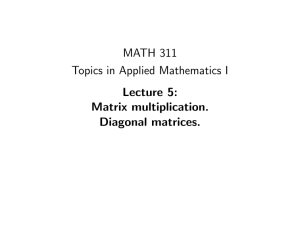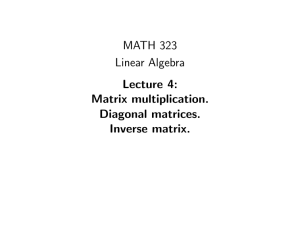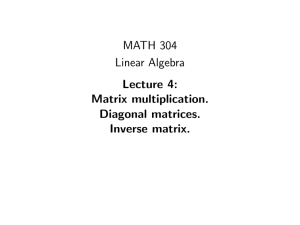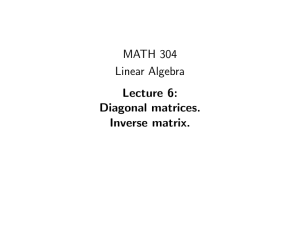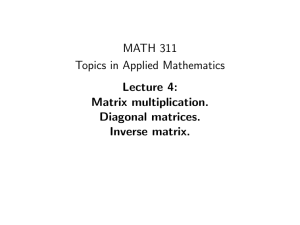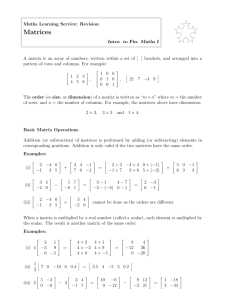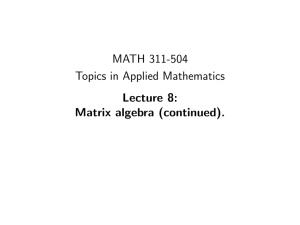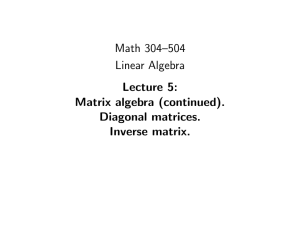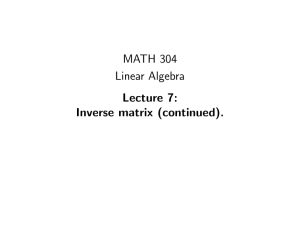MATH 304 Linear Algebra Lecture 6: Diagonal matrices.
advertisement
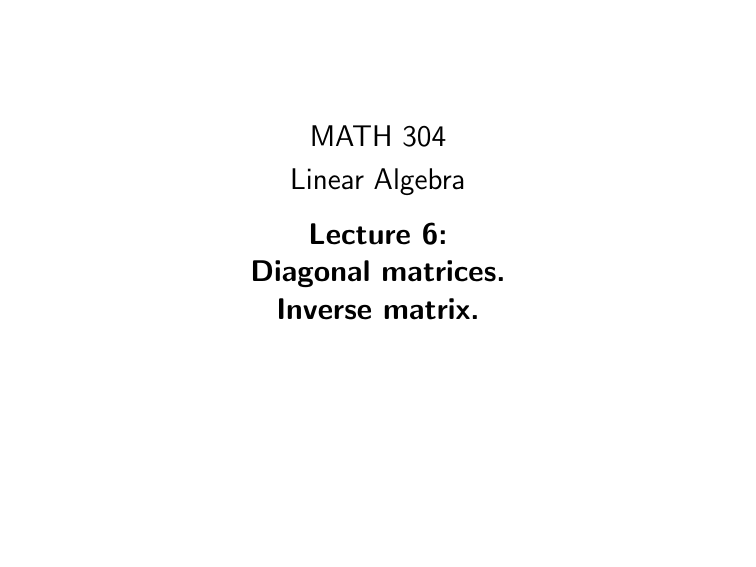
MATH 304 Linear Algebra Lecture 6: Diagonal matrices. Inverse matrix. Matrices Definition. An m-by-n matrix is a rectangular array of numbers that has m rows and n columns: a11 a12 a 21 a22 .. .. . . am1 am2 . . . a1n . . . a2n . . . ... . . . amn Notation: A = (aij )1≤i≤n, 1≤j≤m or simply A = (aij ) if the dimensions are known. Matrix algebra: linear operations Addition: two matrices of the same dimensions can be added by adding their corresponding entries. Scalar multiplication: to multiply a matrix A by a scalar r , one multiplies each entry of A by r . Zero matrix O: all entries are zeros. Negative: −A is defined as (−1)A. Subtraction: A − B is defined as A + (−B). As far as the linear operations are concerned, the m×n matrices can be regarded as mn-dimensional vectors. Properties of linear operations (A + B) + C = A + (B + C ) A+B =B +A A+O =O +A=A A + (−A) = (−A) + A = O r (sA) = (rs)A r (A + B) = rA + rB (r + s)A = rA + sA 1A = A 0A = O Matrix algebra: matrix multiplication The product of matrices A and B is defined if the number of columns in A matches the number of rows in B. Definition. Let A = (aik ) be an m×n matrix and B = (bkj ) be an n×p matrix. The product AB is defined to be the m×p matrix C = (cij ) such that P cij = nk=1 aik bkj for all indices i, j. That is, matrices are multiplied row by column. a11 a12 . . . a1n v1 a 21 a22 . . . a2n v2 A = .. .. . . . .. = .. . . . . vm am1 am2 . . . amn b11 b12 . . . b1p b b . . . b 2p 21 22 B = .. .. . . . .. = (w1 , w2 , . . . , wp ) . . . bn1 bn2 . . . bnp v1 ·w1 v1 ·w2 . . . v1 ·wp v ·w v ·w . . . v ·w 2 p 2 1 2 2 =⇒ AB = .. .. . . . . . . . . vm ·w1 vm ·w2 . . . vm ·wp Any system of linear equations can be represented as a matrix equation: a11 x1 + a12 x2 + · · · + a1n xn = b1 a21 x1 + a22 x2 + · · · + a2n xn = b2 ⇐⇒ Ax = b, ········· am1 x1 + am2 x2 + · · · + amn xn = bm where a11 a12 a 21 a22 A = .. .. . . am1 am2 . . . a1n . . . a2n , . . . ... . . . amn x1 b1 x b 2 2 x = .. , b = .. . . . xn bm Properties of matrix multiplication: (AB)C = A(BC ) (associative law) (A + B)C = AC + BC (distributive law #1) C (A + B) = CA + CB (distributive law #2) (rA)B = A(rB) = r (AB) Any of the above identities holds provided that matrix sums and products are well defined. If A and B are n×n matrices, then both AB and BA are well defined n×n matrices. However, in general, AB 6= BA. 2 0 1 1 Example. Let A = , B= . 0 1 0 1 2 2 2 1 Then AB = , BA = . 0 1 0 1 If AB does equal BA, we say that the matrices A and B commute. Problem. Let A and B be arbitrary n×n matrices. Is it true that (A − B)(A + B) = A2 − B 2 ? (A − B)(A + B) = (A − B)A + (A − B)B = (AA − BA) + (AB − BB) = A2 + AB − BA − B 2 Hence (A − B)(A + B) = A2 − B 2 if and only if A commutes with B. Diagonal matrices If A = (aij ) is a square matrix, then the entries aii are called diagonal entries. A square matrix is called diagonal if all non-diagonal entries are zeros. 7 0 0 Example. 0 1 0, denoted diag(7, 1, 2). 0 0 2 Let A = diag(s1 , s2 , . . . , sn ), B = diag(t1 , t2 , . . . , tn ). Then A + B = diag(s1 + t1 , s2 + t2 , . . . , sn + tn ), rA = diag(rs1 , rs2 , . . . , rsn ). Example. −7 0 0 −1 0 0 7 0 0 0 1 0 0 5 0 = 0 5 0 0 0 6 0 0 3 0 0 2 Theorem Let A = diag(s1 , s2 , . . . , sn ), B = diag(t1 , t2 , . . . , tn ). Then A + B = diag(s1 + t1 , s2 + t2 , . . . , sn + tn ), rA = diag(rs1 , rs2 , . . . , rsn ). AB = diag(s1 t1 , s2 t2 , . . . , sn tn ). In particular, diagonal matrices always commute. Example. 7a11 7a12 7a13 7 0 0 a11 a12 a13 0 1 0 a21 a22 a23 = a21 a22 a23 2a31 2a32 2a33 a31 a32 a33 0 0 2 Theorem Let D = diag(d1 , d2 , . . . , dm ) and A be an m×n matrix. Then the matrix DA is obtained from A by multiplying the ith row by di for i = 1, 2, . . . , m: d1 v1 v1 d v v 2 2 2 A = .. =⇒ DA = .. . . dm vm vm Example. 7a11 a12 2a13 7 0 0 a11 a12 a13 a21 a22 a23 0 1 0 = 7a21 a22 2a23 7a31 a32 2a33 0 0 2 a31 a32 a33 Theorem Let D = diag(d1 , d2 , . . . , dn ) and A be an m×n matrix. Then the matrix AD is obtained from A by multiplying the ith column by di for i = 1, 2, . . . , n: A = (w1 , w2 , . . . , wn ) =⇒ AD = (d1 w1 , d2 w2 , . . . , dn wn ) Identity matrix Definition. The identity matrix (or unit matrix) is a diagonal matrix with all diagonal entries equal to 1. The n×n identity matrix is denoted In or simply I . 1 0 0 1 0 I1 = (1), I2 = , I3 = 0 1 0. 0 1 0 0 1 1 0 ... 0 0 1 . . . 0 In general, I = .. .. . . . .. . . . . 0 0 ... 1 Theorem. Let A be an arbitrary m×n matrix. Then Im A = AIn = A. Inverse matrix Let Mn (R) denote the set of all n×n matrices with real entries. We can add, subtract, and multiply elements of Mn (R). What about division? Definition. Let A ∈ Mn (R). Suppose there exists an n×n matrix B such that AB = BA = In . Then the matrix A is called invertible and B is called the inverse of A (denoted A−1 ). A non-invertible square matrix is called singular. AA−1 = A−1 A = I Examples 1 1 1 −1 −1 0 A= , B= , C= . 0 1 0 1 0 1 1 −1 1 0 AB = = , 0 1 0 1 1 −1 1 1 1 0 BA = = , 0 1 0 1 0 1 −1 0 −1 0 1 0 C2 = = . 0 1 0 1 0 1 1 1 0 1 Thus A−1 = B, B −1 = A, and C −1 = C . Basic properties of inverse matrices: • If B = A−1 then A = B −1 . In other words, if A is invertible, so is A−1 , and A = (A−1 )−1 . • The inverse matrix (if it exists) is unique. Moreover, if AB = CA = I for some matrices B, C ∈ Mn (R) then B = C = A−1 . Indeed, B = IB = (CA)B = C (AB) = CI = C . • If matrices A, B ∈ Mn (R) are invertible, so is AB, and (AB)−1 = B −1 A−1 . (B −1 A−1 )(AB) = B −1 (A−1 A)B = B −1 IB = B −1 B = I , (AB)(B −1 A−1 ) = A(BB −1 )A−1 = AIA−1 = AA−1 = I . −1 −1 • Similarly, (A1 A2 . . . Ak )−1 = A−1 k . . . A2 A1 . Other examples 0 1 1 −1 D= , E= . 0 0 −1 1 D2 = 0 1 0 0 0 1 0 0 = 0 0 . 0 0 It follows that D is not invertible as otherwise D 2 = O =⇒ D −1 D 2 = D −1 O =⇒ D = O. 1 −1 1 −1 2 −2 E2 = = = 2E . −1 1 −1 1 −2 2 It follows that E is not invertible as otherwise E 2 = 2E =⇒ E 2 E −1 = 2EE −1 =⇒ E = 2I .
